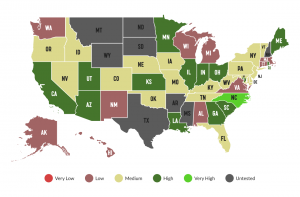QAwerk Report Reveals Significant Accessibility Barriers for People with Disabilities in U.S. Voter Registration Sites
QAwerk conducted an accessibility evaluation of 43 U.S. online voter registration websites, finding that 65% have medium or low accessibility levels.
NEW YORK, NY, UNITED STATES, November 18, 2024 /EINPresswire.com/ -- QAwerk, a leading software testing and quality assurance company, released a new report, "The State of Web Accessibility for U.S. Voters with Disabilities: Barriers to Online Voter Registration in 2024." The report, which evaluated 43 state election websites, found that 65% have medium or low accessibility levels. It
highlights the persistent challenges faced by voters with disabilities when attempting to register to vote online.
Key findings include:
● 83% of U.S. websites offer the option for online voter registration; 15% do not provide online registration functionality, and for 2%, online registration is not required.
● 35% of U.S. websites that offer online voter registration have a high web accessibility index; 42% of those sites have a medium web accessibility index, and 23% have a low web accessibility index.
● North Carolina's DMV website offers the highest level of web accessibility. It scored 14 points out of 15. The only point deducted was for errors in the HTML code.
The state election site of Wisconsin has the lowest web accessibility score. The accessibility barriers concern non-adaptive UI, unclear error messages, no autocomplete feature for forms, missing keyboard navigation, insufficient text contrast, missing input labels, missing link purpose, and HTML errors.
The report found that the most common accessibility issues include:
● HTML Errors: 98% of websites had HTML errors, which can interfere with the proper functioning of assistive technologies like screen readers.
● Missing Labels on Input Fields: 77% of websites lacked proper labels on input fields, making it difficult for screen reader users to understand what information is required.
● Low-Contrast Text: 53% of websites had insufficient color contrast, making reading the content difficult for users with visual impairments.
● Missing Link Purpose: 53% of websites lacked clear link descriptions, confusing users who rely on screen readers to understand the purpose or destination of a link.
QAwerk tested 43 state election sites that allow online voter registration against the Web Content Accessibility Guidelines (WCAG) 2.2, the internationally recognized standard for web accessibility.
The report provides a detailed analysis of the most prevalent accessibility issues and offers best practices for addressing them. It includes specific recommendations for improving website design, coding practices, and content presentation to enhance accessibility for users with disabilities.
The full report, including a state-by-state accessibility ranking, is available here: https://qawerk.com/blog/state-of-web-accessibility-for-us-voters-with-disabilities/
Konstantin Klyagin
QAwerk
email us here
Visit us on social media:
LinkedIn
Legal Disclaimer:
EIN Presswire provides this news content "as is" without warranty of any kind. We do not accept any responsibility or liability for the accuracy, content, images, videos, licenses, completeness, legality, or reliability of the information contained in this article. If you have any complaints or copyright issues related to this article, kindly contact the author above.

